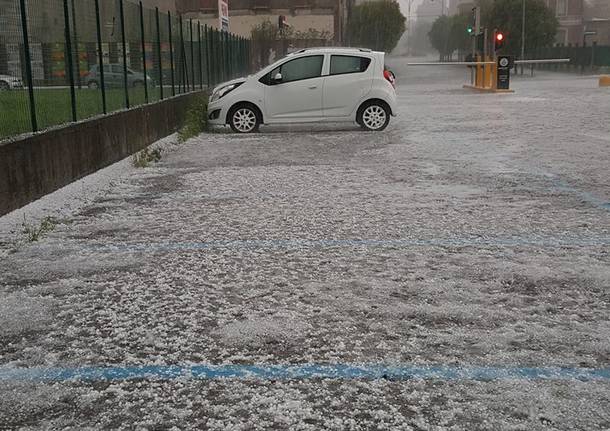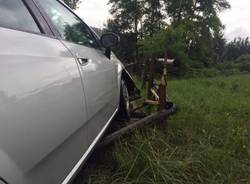Record hailstorm due to “cold drops”
A cloud of warm air rises and collides with the Balkan currents; this is how the hailstones are formed. Be careful on Tuesday evening, as the “fake snow” of May could return.

Nice weather all day, people go swimming in the lake, because “Summer’s here!” But 10 minutes later, everything changes: black clouds, a rainbow, the thunderous storm closing in, and then that incredible hailstorm, one that has never been seen before, hits a handful of villages.
So much hail. The firefighters, who managed to free the cars that had broken down, spoke of 30, in some instances, forty, centimetres of hailstones on the ground.
COLD DROPS – But how do such phenomena come about? An expert from the Pre-Alpine Geophysical Centre, Paolo Valisa, explained. “It’s due to the so-called ‘cold drops’, a meteorological phenomenon that’s generated when masses of lighter, hot air are formed at ground level and create an updraught which collides with clouds of cold air”. (photo by Roberta Cattaneo, the sky on Sunday evening).
So, on nice, warm days, like Sunday, the intense heat on the ground can produce columns of hot air that rise suddenly and meet the approaching cold air mass.
THE “FUN FAIR” EFFECT – At this point, the water particles in the clouds are left suspended and solidify; the more the energy unleashed by the mass of rising hot air, the larger the hailstones, which subsequently fall to earth. It is rather like what happens at a fun fair, on the attractions that generate such a strong airflow that the people are left “floating”; when the airflow stops, they fall to the ground.
RANDOM – However, it is not possible to collect statistical data on hailstones, the expert from the Observatory said.
“At the Pre-Alpine Geophysical Centre in Via Andrea del Sarto, Varese, 37 hailstorm events have been registered since 2000 (18 years), and there have been an average of 30 storms per year. Here is the data, by month: March (3), April (4), May (6), June (4), July (12), August (5), September (0), October (2), November (1),” Paolo Valisia explained, adding, “Hailstorms in Varese Province are not rare, but in any specific place, they aren’t so common, as they are extremely local phenomena.”
This situation has been confirmed also by the mayors of the villages hit yesterday. They spoke about large quantities of hailstones on some sections of road, while others, maybe only a few hundred or dozens of metres away, were spared.
In Varese, for example, not a single hailstone fell, and a total of barely one millimetre of rain fell, which was almost nothing.
EXPECTED REPETITIONS – In the next few days, there may be other hailstorms, perhaps in other areas of the province. Where? It is hard to say. The point is that, over Northern Italy, there is an unstable weather front caused by cold air coming in from the Balkans. This means that, although the satellite pictures show nice weather from the Alps to the Baltic, the “battle” between hot and cold air in our skies could again bring hailstorms. “And this could occur on the evening of tomorrow, Tuesday,” the Pre-Alpine Geophysical Centre warned.
TAG ARTICOLO
La community di VareseNews
Loro ne fanno già parte
Ultimi commenti
Roberto Ganna su Elsa Fornero a Varese: “Abbiamo tolto futuro ai giovani. Ora dobbiamo restituirglielo”
Baffetta su Elsa Fornero a Varese: “Abbiamo tolto futuro ai giovani. Ora dobbiamo restituirglielo”
Fabrizio Tamborini su Elsa Fornero a Varese: “Abbiamo tolto futuro ai giovani. Ora dobbiamo restituirglielo”
Alessandro Zanzi su Elsa Fornero a Varese: “Abbiamo tolto futuro ai giovani. Ora dobbiamo restituirglielo”
Emanuele Zanetti su Motociclista di Ferno ucciso da un orso in Romania
GrandeFratello su Superate le 700 firme per la petizione sul recupero del Grand Hotel Campo dei Fiori di Varese
















Accedi o registrati per commentare questo articolo.
L'email è richiesta ma non verrà mostrata ai visitatori. Il contenuto di questo commento esprime il pensiero dell'autore e non rappresenta la linea editoriale di VareseNews.it, che rimane autonoma e indipendente. I messaggi inclusi nei commenti non sono testi giornalistici, ma post inviati dai singoli lettori che possono essere automaticamente pubblicati senza filtro preventivo. I commenti che includano uno o più link a siti esterni verranno rimossi in automatico dal sistema.